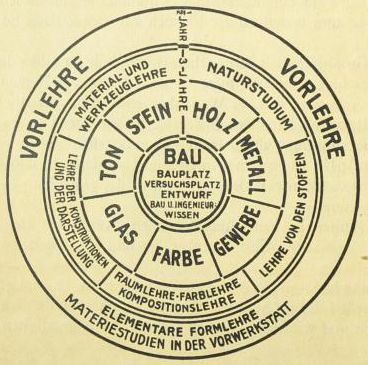Walter Gropius, Conceptual Diagram of the Bauhaus Curriculum (1923)
Abstract
One particularly innovative element of the Bauhaus curriculum was the Preliminary Course [Vorlehre], a semester-long introductory course represented by the outermost ring of this circular diagram by Walter Gropius. In it, first-year students learned the basics of color, form, and composition, and experimented with different materials. After the successful completion of the Preliminary Course, students advanced to one of the workshops (stone, wood, metal, clay, glass, color, or textiles), where, for three years, they received advanced instruction in form in one craft. The workshops offered students a chance to put the lessons of the Preliminary Course into practice. Especially talented students who progressed beyond the workshop stage then received instruction in architecture [Bau], which represented the central core of the curriculum.
Source

Source: Walter Gropius, "Idee und Aufbau des staatlichen Bauhauses," in Karl Nierendorf, László Moholy-Nagy, Herbert Bayer, and Bauhaus, eds., Staatliches Bauhaus, Weimar, 1919-1923. Weimar; Munich: Bauhausverlag, 1923, p. 10. Available online at: http://digital.slub-dresden.de/id477145469/1
This work is licensed under the Creative Commons Attribution-ShareAlike 4.0 License.
Further Reading
Hans M. Wingler, The Bauhaus: Weimar, Dessau, Berlin, Chicago. Translated by Wolfgang Jabs and Basil Gilbert. Edited by Joseph Stein. Cambridge, MA: MIT Press, 1978.